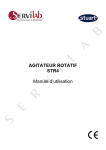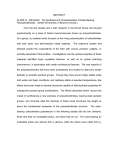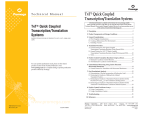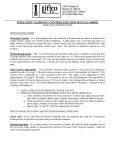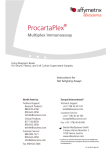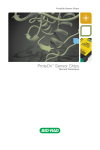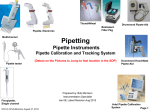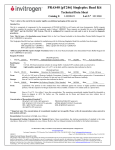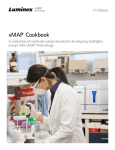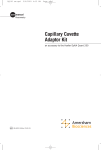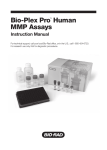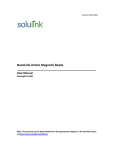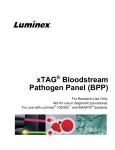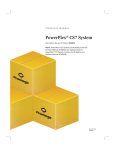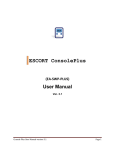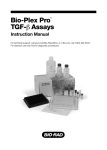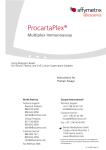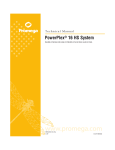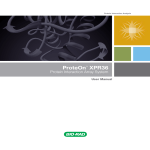Download xMAP® Antibody Coupling Kit User Manual
Transcript
xMAP® Antibody Coupling Kit User Manual Product Catalog Number xMAP® Antibody Coupling Kit 40-50016 For Research Use Only Not For Use In Diagnostic Procedures 89-00002-00-319 Rev B April 2011 © Luminex Corporation, 2001-2011. All rights reserved. No part of this publication may be reproduced, transmitted, transcribed, or translated into any language or computer language, in any form or by any means without prior express, written consent of: LUMINEX CORPORATION 12212 Technology Boulevard Austin, Texas 78727-6115 U.S.A. Voice: (512) 219-8020 Fax: (512) 219-5195 xMAP®Antibody Coupling Kit User Manual PN 89-00002-00-319 Rev. B April 2011 Luminex Corporation (Luminex) reserves the right to modify its products and services at any time. This guide is subject to change without notice. Although prepared to ensure accuracy, Luminex assumes no liability for errors or omissions, or for any damages resulting from the application or use of this information. This guide may be updated periodically. To ensure that you have a current version, access http://www.luminexcorp.com/support The most recent version of this guide is available for download at that URL. The following are registered trademarks of Luminex: Luminex®, Luminex® 100™, Luminex® 100 IS™, Luminex® 200™, Luminex® SD™, Luminex® XYP™, FLEXMAP 3D™, xMAP®, xTAG® Microspheres, MagPlex®, MicroPlex®, MAGPIX™, and xPONENT®. Safety.......................................................................................... 1 Introduction ................................................................................. 3 Method........................................................................................ 4 Protein Considerations................................................................... 5 Kit Contents ................................................................................ Storage and Stability................................................................... Necessary Materials and Equipment .......................................... Instructions ................................................................................. 5 6 6 8 General Workflow........................................................................... 8 Coupling Protocol........................................................................... 8 Coupling Assessment ............................................................... 14 Microsphere Enumeration ............................................................ 14 Coupling Confirmation.................................................................. 14 Sample Coupling Confirmation Protocol ...................................... 14 Troubleshooting ........................................................................ 17 Safety The following informational notes and cautions are used in this manual. NOTE: This message is used to provide general helpful information. IMPORTANT: This message advises users that failure to take action or avoid a certain action can result in data loss or the reporting of incorrect data. You may encounter the symbols in the table below, within this manual.These represent warnings, conditions, identifications, and important information. Table 1: Symbols Symbol Meaning General Warning,Caution, Risk of Danger Manufacturer Decision Point Page 1 of 20 Material Safety Data Sheets (MSDS's) are available upon request. Visit http://www.luminexcorp.com/support for more information. CAUTION: xMAP® Antibody Coupling Kit Sulfo-NHS Solution MAY BE HARMFUL IF ABSORBED THROUGH SKIN OR IF SWALLOWED. MAY CAUSE EYE AND SKIN IRRITATION. CAUTION: xMAP® Antibody Coupling Kit Activation Buffer MAY BE HARMFUL IF ABSORBED THROUGH SKIN OR IF SWALLOWED. CAUTION: EDC causes severe eye irritation. Causes respiratory tract and skin irritation. Page 2 of 20 Introduction The xMAP Antibody Coupling (AbC) Kit contains all of the reagents necessary to covalently couple antibodies to Luminex MagPlex microspheres (beads) in approximately three hours. This kit can also be used to couple other proteins to Luminex microspheres but due to the large diversity in protein composition, coupling performance with other proteins is not guaranteed. For more information on protein coupling please visit: http://www.luminexcorp.com/support Coupling is achieved through carbodiimide reactions involving the primary amino groups on the antibody, or protein of choice, and the carboxyl functional groups on the microsphere surface. This kit is configured for a one-time use* and contains enough reagent to couple as few as 2.5x106 or as many as 50x106 microspheres. The kit can be used to perform as many as ten individual coupling reactions at scales of 2.5x106 to 5x106 microspheres per reaction**; or as many as four reactions at scales of up to 12.5x106 microspheres per reaction. Scale (beads/rxn) Number of Reactions 5x106 or less** 10 Up to 12.5x106 4 IMPORTANT: * Luminex strongly recommends that the EDC reagent be discarded after one use. ** Each coupling reaction requires a minimum of 2.5x106 microspheres. The coupled microspheres can then be used with a Luminex xMAP instrument to develop monoplex or multiplex assays. This kit is ideal for use in two modes: • Coupling optimization and assay optimization: For users developing a new assay, the kit will allow them to perform up to 10 small scale coupling reactions to test multiple concentrations of antibody with multiple bead regions. • Small-to-medium scale assay manufacturing: For users who have already developed and optimized an assay, the kit will allow them to couple up to 50 million beads at once to meet their routine usage needs. Page 3 of 20 With Luminex MagPlex microspheres, if the kit protocol is performed carefully, the percent recovery of the coupling reaction is typically 90% or greater; enough for more than fortyfive 96-well plates (@ 2,500 beads/well) for every 12.5x106 microspheres coupled. Method NOTE: The diagram above illustrates the chemical reaction taking place during coupling and is not intended to be a literal representation of the order in which reagents are added to the reaction. The coupling procedure involves a two-step carbodiimide reaction. The carboxyl groups on the surface of the polystyrene microspheres must first be activated with a carbodiimide derivative prior to coupling the antibody. EDC (1-Ethyl-3-[3dimethylaminopropyl]carbodiimide hydrochloride) reacts with the carboxyl groups on the surface of the microspheres to form an active O-acylisourea intermediate. This intermediate forms a more stable ester using Sulfo-NHS (N-hydroxysulfosuccinimide). The ester reacts with the primary amines (NH2 groups) of antibodies to form a covalent bond (amide linkage). In the protocol described in this manual, the Sulfo-NHS is added to the reaction prior to the addition of EDC to maximize efficiency of the reaction. The presence of Sulfo-NHS in the mixture at the time of the EDC addition is critical due to the limited stability of the EDC microsphere conjugate. The reaction with the carboxylated microsphere does not begin until EDC is added to the mixture. Page 4 of 20 Protein Considerations This kit includes a specially formulated Activation Buffer (pH 6.0) which is suitable for most antibodies. The protein to be coupled must be free of sodium azide, bovine serum albumin (BSA), glycine, tris(hydroxymethyl)aminomethane (Tris), glycerol, or amine-containing additives and should be suspended in phosphate buffered saline (PBS), pH 7.4. A number of buffers can be used successfully in this coupling reaction. Generally, the pH at which a coupling reaction occurs should be compatible with the solubility of the protein of interest. This should be considered when coupling different proteins. Additionally, coupling efficiency will vary depending on a variety of factors, including type of antibody, quantity of antibody, quantity of microspheres, etc. As such, it is recommended that several quantities of antibody input be tested to optimize the coupling reaction and functionality in the final assay. If coupling for the first time, 2-5μg of antibody per 1x106 microspheres is generally a good starting input. The amount of antibody to use in the coupling reaction will depend on the quantity of coupled antibody necessary to promote optimal binding of the desired target molecule. Kit Contents The following items are included in this kit: Component Part Number Volume/Mass Quantity EDC Reagent 11-40144 10 mg 1 Sulfo-NHS 11-25169 250 L 1 Activation Buffer 11-25171 45 mL 1 Wash Buffer 11-25167 30 mL 1 1.5 mL tubes 11-00277 n/a 10 Disposable pipettes 11-00321 n/a 20 (green cap) (ThermoSci #77149) NOTE: The EDC reagent is a Thermo Scientific product and is manufactured for Luminex for use in this kit. For questions regarding the use of this product with this kit, please contact Luminex technical support. Page 5 of 20 Storage and Stability Photosensitive microspheres should be protected from light at all times. All kit components are to be stored at 2-8ºC. The EDC reagent, in its original packaging, may be stored at -20°C to ensure the longest shelf-life possible. All other components should never be frozen. IMPORTANT: Due to the instability of the EDC reagent in solution, it should always be stored in its original sealed packaging until needed and discarded after one use. Reconstituted EDC should never be stored and reused. All components are guaranteed up to the expiration date found on the label; when stored in their original packaging and as specified in this manual. The stability of coupled microspheres is dependent upon several factors; including the protein stability and composition, aseptic processing conditions, presence of preservatives, storage buffer, storage temperature conditions etc. However, stability studies have shown that antibody coupled microspheres, stored in appropriate storage buffer, are stable over a period of 18 months. Necessary Materials and Equipment There are various materials and pieces of equipment that are required for microsphere coupling which are not included with this kit. Required Equipment • Luminex xMAP instrument: MAGPIX, LX100/200, or FLEXMAP 3D • Luminex xPONENT software • Luminex MagPlex Microspheres (Cat# MC1XXXX-01, -04, & MC10XXX-ID) NOTE: Visit http://www.luminexcorp.com/Products/ReagentsMicrospheres/MAGPLEX-MICROSPHERES for a complete list of MagPlex® microspheres and guidelines for selecting the right regions for your instrument. • Luminex Instrument Performance Calibration and Verification Kits • Luminex Instrument Sheath Fluid (LX100/200 & FLEXMAP 3D) or Drive Fluid (MAGPIX) • Magnetic Separator Other Necessary Equipment • Tube Rotisserie or Rotator • Water-bath sonicator Page 6 of 20 • Vortexer • Pipettor Optional Equipment • Luminex Tube Magnetic Separator (Cat# CN-0288-01) • Microcentrifuge • Luminex Plate Magnetic Separator (Cat# CN-0269-01) Page 7 of 20 Instructions General Workflow Coupling Protocol The following is the detailed step-by-step process for coupling antibodies (or similar proteins) to carboxylated magnetic microspheres. IMPORTANT: Protect photosensitive microspheres from light whenever possible throughout this entire procedure. 1. 2. 3. Remove kit and all reagents from the refrigerator and allow them to equilibrate to room temperature for 20-30 minutes. While the reagents equilibrate to room temperature, calculate and note the required volumes for Decision Point steps 4, 8, 11, 13, 19, and 20; for each reaction being performed. Resuspend the stock microspheres. • If using a 1mL stock microsphere vial, vortex the stock microsphere vial for 10 seconds and then sonicate for 10 seconds to disperse the microspheres. Alternatively, the microsphere vials can be rotated on a rotator for 15 minutes. • If using a 4mL stock microsphere vial, rotate the vial for 15 minutes at 15-30 rpm. Page 8 of 20 4. Dispense the desired amount of microspheres from the stock vial into one of the microcentrifuge tubes (“reaction tube”) provided with the kit. Example Calculation: If coupling 5 million microspheres, with microsphere stock concentration of 12.5x106 microspheres: IMPORTANT: This kit is designed for a maximum of 12.5x106 microspheres per reaction tube. 5. Wash the microspheres. A. Place the reaction tube with microspheres into the magnetic separator for 1-2 minutes. NOTE: If performing multiple reactions simultaneously, a microcentrifuge may be used, in place of a magnetic separator, to pellet the microspheres during wash steps. Beads can be pelleted by microcentrifugation at ≥ 8000 x g for 1-2 minutes. B. With the tube still positioned in the magnetic separator, remove the supernatant with transfer pipette. NOTE: For your convenience, twenty disposable transfer pipettes have been included for the removal of supernatant during the various wash steps in this protocol. If using one pipette for the removal of Activation Buffer and one for the removal of Wash Buffer, the kit should have enough to perform up to ten individual reactions. (i.e. 2/rxn) Special care should be taken to avoid cross contamination, when performing multiple reactions simultaneously. C. Add 500 μL of Activation Buffer into the reaction tube. D. Vortex the reaction tube for 10 seconds and then sonicate for 10 seconds to disperse the microspheres. 6. Repeat Step 5 once for a total of two washes. Page 9 of 20 7. 8. Place the reaction tube with microspheres into the magnetic separator for 1-2 minutes and, with the tube still positioned in the magnetic separator, remove the supernatant with a transfer pipette. Add Activation Buffer into the reaction tube. • If coupling more than 5x106 microspheres, add 400 μL of Activation Buffer into the reaction tube. • If coupling 5x106 microspheres or less, add 480 μL of Activation Buffer into the reaction tube. 9. Vortex the reaction tube for 10 seconds and then sonicate for 10 seconds to disperse the microspheres. 10. Vortex the provided Sulfo-NHS tube for a minimum of 10 seconds. 11. Add Sulfo-NHS solution to the reaction tube. • If coupling more than 5x106 microspheres, add 50 μL of the Sulfo-NHS solution into the reaction tube. • If coupling 5x106 microspheres or less, add 10 μL of the Sulfo-NHS solution into the reaction tube. 12. Add 250 μL of Activation Buffer into the 10 mg vial of EDC. Invert the EDC vial and then vortex the vial for 10-12 seconds to dissolve the EDC. IMPORTANT: EDC will begin to degrade once exposed to moisture in the atmosphere and the Activation Buffer. Once opened the EDC solution must be prepared and used quickly. If performing multiple reactions, be sure to prepare all of them prior to this step so that the EDC solution can be quickly added to all of the reaction tubes immediately after dissolution. The EDC solution must be made fresh for each coupling event and the excess should be discarded. 13. Add EDC Solution to reaction tube. • If coupling more than 5x106 microspheres, add 50 μL of the EDC solution into the reaction tube. • If coupling 5x106 microspheres or less, add 10 μL of the EDC solution into the reaction tube. 14. Vortex the reaction tube for a minimum of 10 seconds. 15. Protect microspheres from light and incubate at room temperature for 20 ± 1 minutes and vortex the microspheres again, for 10 seconds, halfway through the incubation period. Alternatively, this incubation step can be done on a rotator at 1530 rpm for 20 minutes, without vortexing. Page 10 of 20 16. Wash the microspheres. A. Place the reaction tube with microspheres into the magnetic separator for 1-2 minutes. B. With the tube still positioned in the magnetic separator, remove the supernatant with a transfer pipette. C. Add 500 μL of Activation Buffer into the reaction tube. D. Vortex the reaction tube for 10 seconds and then sonicate for 10 seconds to disperse the microspheres. 17. Repeat Step 16 twice, for a total of three washes. 18. Place the reaction tube with microspheres into the magnetic separator for 1-2 minutes and, with the tube still positioned in the magnetic separator, remove the supernatant with a transfer pipette. 19. Calculate volume of antibody to be used in the reaction. • Typically, a range of 2-5 μg of antibody per 1x106 microspheres is a good starting point, if performing the coupling reaction for the first time. Example Calculation: If coupling 5 million microspheres, with an antibody at a concentration of 5 mg/mL, and using the suggested starting point of 5 μg of antibody per 1x106 microspheres Page 11 of 20 20. Calculate the volume of Activation Buffer needed for the reaction. • If coupling more than 5x106 microspheres, subtract the volume of antibody calculated in Step 19 from 1000 μL. • If coupling 5x106 microspheres or less, subtract the volume of antibody calculated in Step 19 from 500 μL. Example Calculation: If 5 μL of the stock antibody is needed (as calculated in the example in Step 19) for the coupling of 5 million microspheres: Volume of Activation Buffer needed = (1000μL or 500μL) - (Volume of Ab needed) Volume of Activation Buffer needed = 500μL - 5μL Volume of Activation Buffer needed = 495μL 21. Add the appropriate volume of Activation Buffer, calculated in Step 20, to the reaction tube. 22. Add the appropriate volume of antibody, calculated in Step 19, to the reaction tube. 23. Vortex the reaction tube for a minimum of 10 seconds. 24. Protect microspheres from light and rotate on rotator for 2 hours. (Rotation speed should be ~15-30 rpm) 25. Wash the microspheres. A. Place the reaction tube with microspheres into the magnetic separator for 1-2 minutes. B. With the tube still positioned in the magnetic separator, remove the supernatant with a transfer pipette. C. Add 500 μL of Wash Buffer into the reaction tube. D. Vortex the reaction tube for 10 seconds and then sonicate for 10 seconds to disperse the microspheres. 26. Repeat Step 25 twice, for a total of three washes. 27. Place the reaction tube with microspheres into the magnetic separator for 1-2 minutes and, with the tube still positioned in the magnetic separator, remove the supernatant with a transfer pipette. 28. Add 1 mL of Wash Buffer into the reaction tube. NOTE: The Wash Buffer is used as a storage buffer after completing the coupling reaction. 29. Vortex the reaction tube for 10 seconds and then sonicate for 10 seconds to disperse the microspheres. 30. Protect from light and store at 2-8 ºC until needed. Page 12 of 20 NOTE: For optimal performance allow the coupled microspheres to block overnight before first use. Page 13 of 20 Coupling Assessment Once the coupling reaction has been completed, the coupled microspheres can be enumerated and the efficiency of the coupling reaction assessed. Microsphere Enumeration Although, the protocol described in this manual will typically yield over a 90% recovery, it is recommended that the user count the number of microspheres actually recovered after each coupling reaction. This can be done with the use of a cell counter or hemacytometer. Please refer to the cell counter or hemacytometer’s users manual for appropriate instructions for doing so. Coupling Confirmation It is strongly recommended to assess coupling efficiency before proceeding to assay development. The coupled microspheres can be reacted with a phycoerythrin (PE)labeled target or antibody that binds to the coupled protein. Alternatively, the target or antibody may be biotinylated, then labeled with PE. This complex can then be analyzed on a Luminex xMAP instrument. The intensity of the fluorescent signal of this reaction is directly proportional to the amount of protein on the surface of the microspheres. This process provides a rapid assessment of the relative amount of protein coupled to the microspheres; however, this does not necessarily verify the functionality of the protein. The ultimate test is the functional assay of the coupled protein. Sample Coupling Confirmation Protocol 1. 2. 3. Select the appropriate antibody-coupled microsphere set or sets. Resuspend the microspheres by vortex and sonication for approximately 20 seconds. Prepare a working microsphere solution by diluting the coupled microsphere stocks to a final concentration of 50 beads/μL in PBS-1% BSA. NOTE: Up to 4 different microsphere sets may be prepared in the same mixture (in multiplex), provided each set is a different microsphere region and the various antibodies coupled to those regions can be detected with the same detection antibody. NOTE: At least 1mL of the microsphere solution is required for each reaction. NOTE: Either PBS-1% BSA or PBS-BN (PBS, 1% BSA, 0.05% Azide, pH 7.4) may be used as Assay Buffer. Page 14 of 20 Prepare a solution of phycoerythrin-labeled anti-species IgG detection antibody at 4 μg/mL in PBS-1% BSA. Prepare a 1:2 dilution series of that detection antibody solution to a concentration of 0.0625 μg/mL as shown in the following table. 4. Volume of PBS-1% BSA Dilution Tube Volume of Detection Antibody Concentration 1:1 - - 4 μg/mL 1:2 500 μL 500 μL from Tube 1:1 2 μg/mL 1:4 500 μL 500 μL from Tube 1:2 1 μg/mL 1:8 500 μL 500 μL from Tube 1:4 0.5 μg/mL 1:16 500 μL 500 μL from Tube 1:8 0.25 μg/mL 1:32 500 μL 500 μL from Tube 1:16 0.125 μg/mL 1:64 500 μL 500 μL from Tube 1:32 0.0625 μg/mL NOTE: For optimal results use Costar round-bottom 96-well plates and Luminex Magnetic Plate Separator with MagPlex microspheres. 5. Aliquot 50 μL of the microsphere solution prepared in Step 3 into two entire columns of wells of the plate (duplicate sets of 8 wells, 16 wells total). Add 50 μL of PBS-1% BSA, as a blank sample, into the wells in Row A containing the microsphere solution. Add 50 μL of each of the diluted detection antibody solutions prepared in Step 4 into the appropriate wells of the plate (as shown in the plate layout below). 6. 7. 1 2 A Blank Blank B 1:64 1:64 C 1:32 1:32 D 1:16 1:16 E 1:8 1:8 F 1:4 1:4 G 1:2 1:2 H 1:1 1:1 3 4 5 6 7 8 9 10 11 12 Example plate layout using columns 1 & 2 Page 15 of 20 8. Mix the reactions gently by pipetting up and down several times with a pipettor. 9. Cover the plate and incubate for 30 minutes at room temperature on a plate shaker. 10. Clip the plate in place on the Luminex Magnetic Plate Separator and rapidly and forcefully invert over a biohazard receptacle to evacuate the liquid from the wells. NOTE: For information on the MagPlex Manual Wash Method, please visit: http://www.luminexcorp.com/Products/ReagentsMicrospheres/MAGPLEXMICROSPHERES 11. Wash each well with 100 μL of PBS-1% BSA by gently pipetting up and down several times with a pipettor, and remove the liquid by using the procedure described in the previous step. 12. Repeat the previous wash step once. 13. Resuspend the microspheres in 100 μL of PBS-1% BSA by gently pipetting up and down several times with a pipettor. 14. Analyze 50-75 μL on the Luminex analyzer according to the system manual. An example of typical results is shown below. Page 16 of 20 Troubleshooting This troubleshooting guide may be helpful in solving problems that may arise. For more information, call Technical Support toll free at 1-877-785-BEAD (2323). Outside of U.S. and Canada, call +1 512-381-4397. Send e-mail inquiries to: [email protected]. Problem Possible Cause(s) Recommendations Low Bead Count Uncoupled microspheres tend to stick to the inner surfaces of some tubes Make sure to use tubes supplied in this kit only. Microspheres were lost during washes Use the recommended magnetic separator to perform all washes. See Recommended Material list. Use the transfer pipette to remove all supernatant during washes. The microsphere pellets are loose and using a pipettor could disturb the bead pellet. Incorrect probe height adjustment Adjust probe height according to the Luminex®200™, FLEXMAP 3D® or MAGPIX® user manual. Incorrect protocol setup on the Luminex instrument Make sure correct microsphere regions are selected based on your particular custom designed assay. Page 17 of 20 Problem Possible Cause(s) Recommendations Low/No signals The reagents may not have been stored correctly Store all reagents as recommended EDC may not have been stored correctly or rehydrated long before use EDC must remain in the pouch it is shipped in until ready to use. EDC must be used immediately in the coupling procedure after rehydration. The stock protein concentration is possibly low Make sure the protein concentration is correct and the recommended amount is coupled to the microspheres The stock protein suspension possibly contains foreign proteins, azide, glycine, Tris or some primary amines Dialyze the protein of interest to remove the competing substances The reaction volumes and/or mixing method may be incorrect The final reaction volume for the 2 hr incubation is critical for successful coupling. Refer to the protocol. End-toend mixing during the 2 hr incubation is very important. Please use an optical rotator. The anti-species detection antibody may not be correct Make sure the anti-species detection antibody is correct, for example if you are using a mouse monoclonal to couple to the microspheres, use an anti-mouse detection antibody. Make sure the anti-species detection antibody has the appropriate label on it, either biotin or phycoerythrin. Page 18 of 20 Page 19 of 20 Page 20 of 20
























